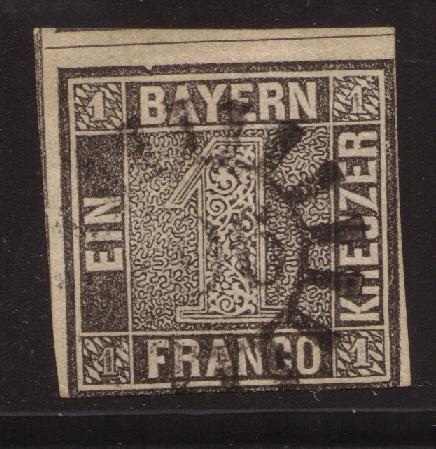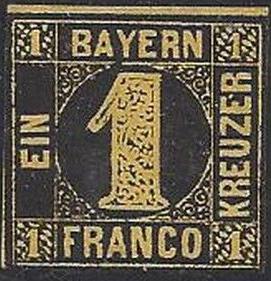 |
|||||
|
|||||
| Preview of Stamps Catalogue: VOLUME 1 |
 |
|||||
|
|||||
| Preview of Stamps Catalogue: VOLUME 1 |
Bayern - Bavière - Beieren
Return To Catalogue - 1849 issue, 1 kr black forgeries, part 1 - 1849 issue, 1 kr black forgeries, part 2- 1849 issue, forgeries of the other values - 1867-1876 issue - 1876-1913 issues - 1914-1918 issues - 1919-1920 issues - Official Stamps - Postage Due and Telegraph Stamps - Miscellaneous - Other German States - Germany
Note: on my website many of the
pictures can not be seen! They are of course present in the catalogue;
contact me if you want to purchase it.
Currency: 60 Kreuzer = 1 Gulden, after 1875 100 Pfennig = 1 Mark





The so-called 'Schwarze Einser'.
1 k black (the so-called 'Schwarze Einser') 1 l red 1 k yellow 3 k blue 3 k red 6 k brown 6 k blue 9 k green 9 k brown 12 k red 12 k green 18 k yellow 18 k red


6 kr Type I on the left and Type II on the right. The circle
containing the "6" is smaller in Type II. Also for
example the both "S" of "SECHS" are
different.

For the specialist: these stamps (exept the 1 kr black) have a silk thread (from top to bottom). A 1 k black with silk thread is a proof. Note that the 1 k black has a slightly different design. These stamps were printed in sheets of 90 (two panes consisting of nine rows of five stamps). The 3 k red, 6 k blue and 9 k brown were issued in colors corrresponding to the German-Austrian Postal Union convention.
Value of the stamps |
|||
vc = very common c = common * = not so common ** = uncommon |
*** = very uncommon R = rare RR = very rare RRR = extremely rare |
||
| Value | Unused | Used | Remarks |
| 1 k black | RRR | RRR | Issued 1st November 1849 (first stamp in Germany). Usual cancel: closed millwheel. For forgeries, click here or here Exists in tete-beche: only 4 pairs known. The famous stamp collector Ferrary possesed a block of 12 stamps with a tete-beche stamp. |
| 1 k yellow | *** | ** | 1862 |
| 1 k red | ** | ** | 1850 |
| 3 k blue | ** | c | 1850 |
| 3 k red | *** | c | 1862, printed in red to conform with the German-Austrian postal union recommendations. |
| 6 k brown | ** | c | 1849, Two types, complete circle or broken circle. |
| 6 k blue | *** | * | 1862, printed in blue to conform with the German-Austrian postal union recommendations. |
| 9 k green | *** | * | Issued 1st July 1850 |
| 9 k brown | *** | ** | 1862, printed in brown to conform with the German-Austrian postal union recommendations. |
| 12 k red | R | R | 1858 |
| 12 k green | *** | *** | 1862 |
| 18 k yellow | R | R | 1854 |
| 18 k red | R | R | 1862 Also orange |
Local letters and printed matter required a stamp of 1 k. Normal letters needed a 3 k stamp and a 6 k stamp was needed on letters for longer distances (greater than 12 German miles). After Bavaria joined the German-Austrian Postal Union a new value 9 k was issued for the rate for letters between the states. This was done on 1st July 1850. The 12 k rate was used for letters to France (July 1858).
The first cancels to be applied on stamps in 1849 were towncancels.
On 12th November 1849 it was decided that an additional pencancel
(cross-like) should be applied to the stamp if the cancel didn't
or barely touched the stamp. On 1st August 1850 the so called closed
millwheel cancels (geschlossenen or voller
Mühlradstempel in German) were introduced (so called '1er
Verteilung'). This cancel was applied to the stamps,
while the towncancel was applied elsewhere on the letter.
Initially 402 of such cancels were introduced. Each number
corresponded to a town arranged alphabetically (thus 1: Abensberg
to 402: Zwiesel). Additional new post offices received new
numbers and were introduced in groups (also arranged
alphabetically). Closed millwheel cancel '406' was a railway
cancel. 603 closed millwheel cancels existed towards the end of
its use. All closed millwheel cancels have 16 rays (except for
number '217' used in Munich which has 17 rays). The closed
millwheel cancels were surpressed on 20 November 1856 and the
postoffices were required to send their cancellers back to
Munich. From then to 1 December 1856 only towncancels were used
on stamps. A redistribution (2er
Verteilung) of the numbers followed from 1 December 1856
onwards based again on alphabetical order. Cancels that were
unusable were replaced by a new type the open millwheel cancel
(Offener Mühlradstempel in German). Also the open millwheel
cancel 'B.P.' was introduced ('B.P'= Bahnpost or railway cancel).
New post offices received new numbers again until the number 922
was reached. Open millwheel cancels exist in several sizes.
Officially the last date for the use of millwheel cancels was 9
March 1869 (though some are known to exist beyond that date).
From 10 March 1869 onwards towncancels were used once again.
Since several numbers were re-assigned it is not always possible
to ascertain in which town the stamp was cancelled. Source:
http://www.klassische-philatelie.ch/ad/altdeutsch_bayern_muehlrad.html.
A special 'Rhombusstempel' consisting of a lozenge with
horizontal lines inside it and number '325' was used as a test in
Munich in 1866 (rare).
Much more information can be found in the book 'Bayrische
Mühlradstempel' by Joh. Wilh. Stündt, Nürnberg, 1917 (Hugo
Krötzsch, Philatelistischer Verlag Leipzig, can also be
downloaded from http://www.archive.org); it includes a complete
list of towns and numbers.


('Mühlrad' or millwheel cancel, two types; left open, right
closed)

'Rhombusstempel' consisting of a lozenge with horizontal lines
inside it and number '325', used as a test in Munich in 1866.
Some numbers and their corresponding towns for
the Closed Millwheel cancels (1er Verteilung):
6:Altdorf
12: Ansbach
14: Aschaffenburg
18: Augsburg
20: Bamberg
23: Bayreuth
27: Berchtesgaden
84: Feucht
90: Freilassing
91: Freising
98: Furth
111: Gollheim (Pfalz)
119: Haag
135: Hof
145: Ingolstadt
148: Kaiserslautern
155: Kempten
159: Kissingen
175: Landshut
187: Lichtenfels
188: Lindau
189: Lohr
190: Ludwigshafen
217: München
243: Nürnberg
255: Ottobeuren
260: Passau
268: Pirmasens
281: Regensburg
325: Speyer
363: Vohburg
396: Wurzburg
402: Zwiesel
603: Ipsheim
Open and closed Millwheel cancels (2er
Verteilung):
28: Augsburg
247: Kirchheimbolanden (open)
788: Kolbermoor (open)
B.P.: Bahnpost (railroad post)

A 'Postablage' cancel with "POSTABLAGE" in a straight
line and the townname below it.

'Balkenstempel': city name in a straight line with date below,
here "MUNCHEN" (Munich)

'243' Nürnberg closed millwheel cancel (1er Verteilung),
elsewhere on the letter a towncancel was placed 'Nurnberg'.


Certified genuine colour proof of a 1 k stamp, front and backside
I've seen many 'proofs' being offered on Ebay recently (2005). I'm not quite sure if these are not just ordinary forgeries. I have indications that these are made by the forger Peter Winter.






Blackprint (instruction-stamp); such blackprints exists for other
values as well. They were used on parcels with stamps which were
send to the post offices. The clerks could thus easily see which
stamps were in the parcels.
The background color of such blackprints
corresponded to the color of the stamps in the parcel. Thus the
above 3 k black on blue was used for 3 k blue stamp parcels. For
the 1 k grey was used, for the 6 k brown or blue, the 9 k green,
the 12 k red and the 18 k yellow.
Note: the book "Die Briefmarken von Altdeutschland" by
K.K.Doberer mentions that these 'instructionstamps' or
'instruktionsmarken' are the most forged stamps of Bavaria. I
have not much information concerning forgeries. I have seen some
12 kr blackprint forgeries (black on green and black on lilac),
in which the '2's in the corners have wavy bottoms (should be
straight). If anyone has more information, please contact me!

Most likely a forgery, the top left part of the large
"1" is curved.


Most likely a forgery of a 9 k intruction stamp. The small '9's
in the corners are quite different from the genuine stamps.

Most likely a forgery of the 6 k value. The top part of the large
"6" is touching the bottom part.


Forged instruction stamps, in my opinion the top left part of the
large "1" is not long enough.


18 k instruction stamp forgeries, the first one with
"FALSCH" written at the back. In my view, the top left
part of the large "1" is not long enough.


A few dubious instruction stamps, probably forgeries.
For information of forgeries of the Bavaria 1849 1 kr black issue, click here or here. For forgeries of the other values, click here.
For issues of Bavaria in the period 1867 to 1876 click here.